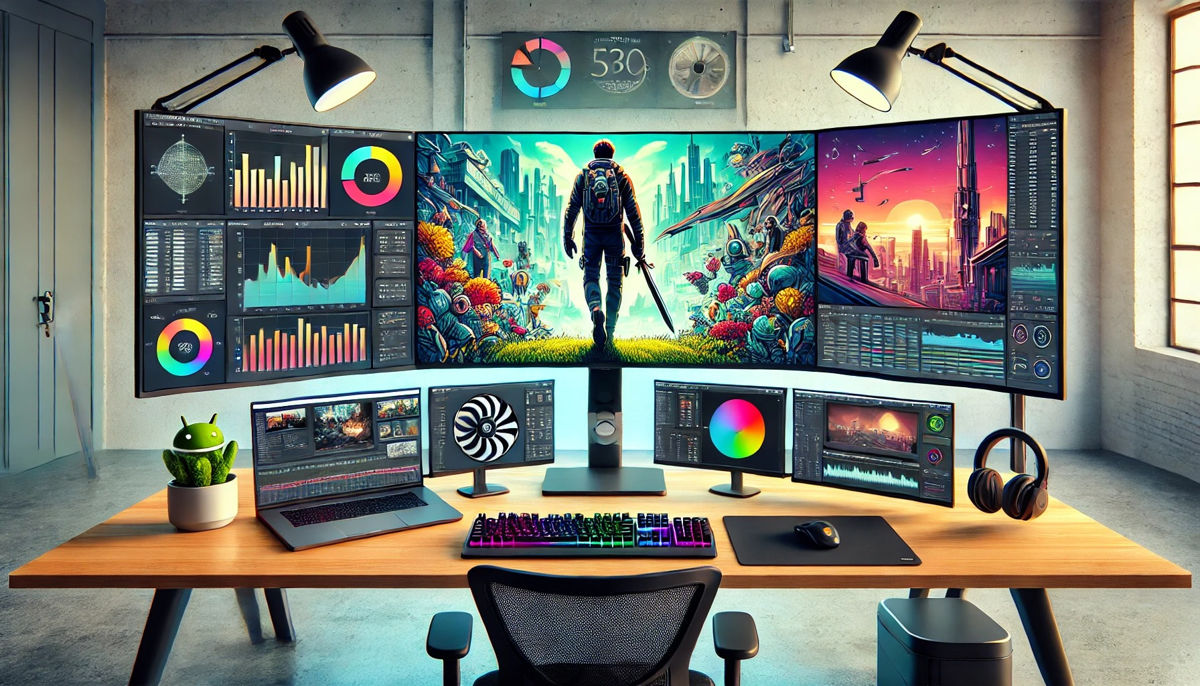If you’re searching for the best ultrawide monitors 2025, you’re in the right place. Whether you’re a content creator, a remote worker, or a gamer, ultrawide monitors can dramatically improve your workflow and gaming experience.
Ultrawide monitors have evolved, offering curved screens, 144Hz refresh rates, and 4K resolutions that rival dual-monitor setups. In this guide, we’ll break down the best ultrawide monitors for gaming, productivity, and content creation, including budget-friendly models and high-end curved displays.
If you’ve ever wondered, “Are curved ultrawide monitors better for your eyes?” or “Is an ultrawide better than dual monitors?”, we’ll answer those questions too. Let’s dive in.
Disclosure
Some of the links in this post are affiliate links, which means I may earn a small commission if you click and buy. As an Amazon Associate, I earn from qualifying purchases.
What is an Ultrawide Monitor?
An ultrawide monitor is a widescreen display with a 21:9 or 32:9 aspect ratio, offering significantly more horizontal space than standard 16:9 monitors. These screens are designed for:
✅ Work & Productivity – Run multiple apps side by side without extra monitors.
✅ Gaming & Immersion – Enjoy a wider field of view (FOV) in open-world and FPS games.
✅ Content Creation – Get a wider timeline for video editing or more room for creative projects.
Some of the best ultrawide monitors for work and gaming in 2025 include features like USB-C connectivity, high refresh rates (144Hz+), and OLED or IPS panels for improved color accuracy.
Understanding Monitor Curvature: Which One is Right for You?
Monitor curvature is measured in radius (R), with lower numbers indicating a more pronounced curve. The curvature directly impacts immersion, viewing comfort, and usability. Here’s a breakdown of common curvature ratings:
- 3800R (Subtle Curve): Ideal for general productivity and office work. The gentle curve offers a slight wrap-around effect while keeping onscreen elements relatively undistorted.
- 2500R-3000R (Moderate Curve): A balance between immersion and usability. Suitable for multitasking, video editing, and gaming without distorting straight lines too much.
- 2300R (Deep Curve): Designed for immersive experiences, reducing eye strain by keeping the screen’s edges within the natural field of view. Great for creative professionals and gamers who want an engaging experience.
For the best ultrawide monitors for productivity, opting for a monitor with a moderate curvature (2300R-3000R) is ideal, as it helps reduce the amount of head movement while still providing an expansive viewing area.
Why You Should Pick an Ultrawide Monitor
More Screen Real Estate for Productivity
- Ultrawide monitors offer substantial advantages over traditional 16:9 displays for productivity, making them the preferred choice for professionals, content creators, and multitaskers. Here’s why the best ultrawide monitors for productivity can significantly enhance your workflow:
- Increased Screen Real Estate: With a 21:9 or 32:9 aspect ratio, these monitors provide more workspace, allowing users to have multiple applications open side by side without needing dual monitors.
- Reduced Eye Strain: Curved ultrawide monitors reduce eye fatigue by ensuring the edges of the screen remain within the user’s peripheral vision, eliminating excessive head movement.
- Seamless Multitasking: Whether you’re managing spreadsheets, coding, or editing videos, the best ultrawide monitors for work enable efficient multitasking with split-screen layouts.
- Ideal for Creative Workflows: Graphic designers, video editors, and content creators benefit from the wider field of view for precise detailing, color correction, and timeline adjustments.
- Better Connectivity & Cable Management: Many best ultrawide monitors for MacBook Pro and USB-C users come with Thunderbolt 4, HDMI 2.1, and USB-C with power delivery, reducing cable clutter while ensuring high-speed data transfer.
Overall, ultrawide monitors offer a superior workspace for professionals who need better screen organization, reduced distractions, and a comfortable viewing experience compared to traditional flat monitors.
Best Ultrawide Monitors for Gaming – The Competitive Edge
Gaming on an ultrawide monitor isn’t just about a bigger screen—it’s about an immersive, high-performance experience that gives players an edge in various genres. The best ultrawide monitors for gaming provide advantages that traditional 16:9 monitors can’t match. Here’s why they’re becoming the preferred choice for serious gamers:
🎮 Wider Field of View (FOV) for a Competitive Advantage
- In FPS, racing, and open-world games, an ultrawide monitor offers a broader peripheral view, allowing players to see more of the game world at once.
- Many competitive titles now support 21:9 resolutions, making ultrawide monitors an essential tool for players who want a tactical advantage.
- The best ultrawide monitors for FPS gaming allow players to spot enemies earlier in games like Call of Duty, Apex Legends, and Battlefield due to the extended screen space.
🚀 High Refresh Rates & Low Latency for Smooth Gameplay
- 144Hz and 240Hz refresh rates ensure fluid motion, reducing screen tearing and stutter during fast-paced action.
- Many of the best ultrawide gaming monitors now support G-Sync and FreeSync, preventing screen tearing and improving responsiveness.
- Gamers looking for the best ultrawide monitor for racing games benefit from lower response times (1ms-2ms), high refresh rates, and immersive curves that enhance speed perception.
Are Curved Ultrawide Monitors Better for Your Eyes?
Scientific research supports the idea that curved monitors are easier on the eyes compared to flat screens:
- A Harvard study found that curved monitors reduce eye strain during long working hours.
- A Journal of Ergonomics study showed that curved screens help eliminate distortion at the edges, making it easier to focus.
- The natural curvature mimics how our eyes see the world, reducing the need for constant refocusing.
For users experiencing eye fatigue, migraines, or strain from long screen sessions, the best ultrawide monitors for reducing eye fatigue come with blue light filters and anti-glare coatings.
Ultrawide vs. Flat Monitors – Which One Should You Get?
Choosing between an ultrawide monitor and a traditional flat monitor depends on your needs.
Ultrawide Monitors – Best for Work & Immersion
✅ More screen real estate – perfect for multitasking and content creation.
✅ Curved ultrawide monitors reduce eye strain (backed by studies).
✅ Immersive experience for gaming and movies.
✅ Eliminates the need for dual monitors, reducing desk clutter.
❌ More expensive than traditional flat monitors.
Flat Monitors – Best for Budget Buyers & Esports
✅ More affordable than ultrawide models.
✅ Preferred by competitive FPS gamers due to less distortion.
✅ Great for office work if you don’t need extra space.
❌ Limited screen real estate, requiring multiple monitors for multitasking.
Verdict:
- If you need extra space for work, gaming, or content creation, go ultrawide.
- If you mainly play competitive FPS games and prefer a standard display, stick with a flat high-refresh-rate monitor.
- If eye comfort is a priority, the best ultrawide monitors for reducing eye strain are curved models with anti-glare tech.
Best Ultrawide Monitors for Productivity
Quick Comparison
| Monitor | Screen Size | Resolution | Refresh Rate | Connectivity | Curvature | Buy Now |
|---|---|---|---|---|---|---|
| LG 34WP65C-B | 34 inches | 3440 x 1440 | Up to 144Hz | HDMI, DisplayPort, USB-C | 3800R | Check Price |
| LG 38WR85QC-W | 38 inches | 3840 x 1600 | 144Hz | HDMI 2.1, USB-C (90W PD), Ethernet | 2300R | Check Price |
| Dell U4025QW | 40 inches | 5120 x 2160 | 120Hz | Thunderbolt 4, HDMI 2.1, DisplayPort | 2500R | Check Price |
LG 34WP65C-B
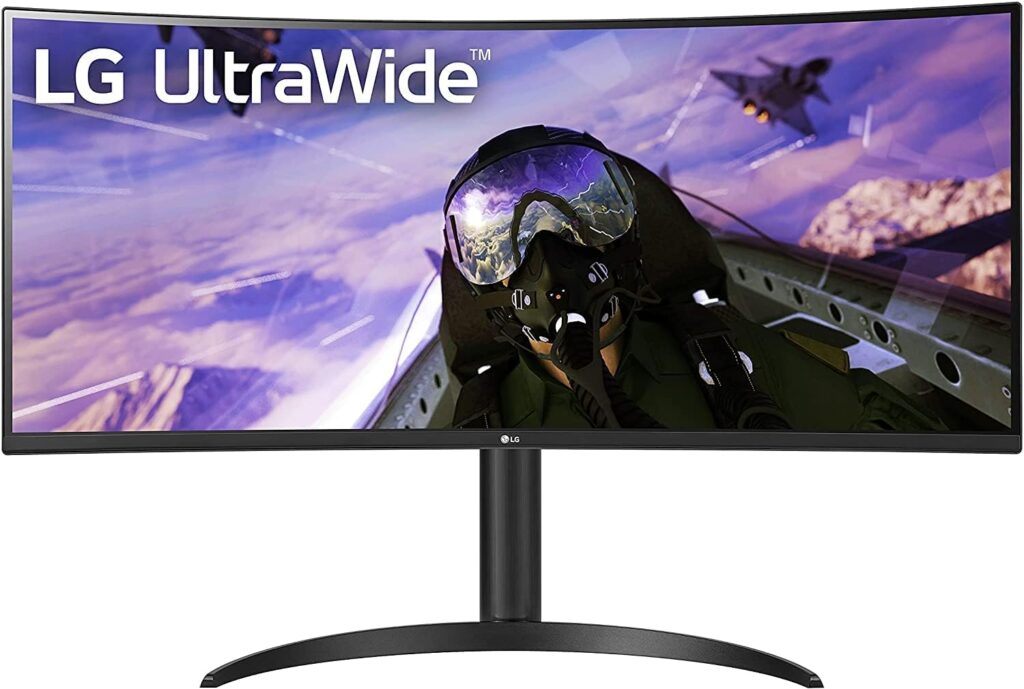
Key Specs:
- Screen Size: 34 inches
- Resolution: 3440 x 1440 (QHD)
- Panel Type: IPS
- Refresh Rate: Up to 144Hz
- Connectivity: HDMI, DisplayPort, USB-C
- Features: HDR10, AMD FreeSync
Overview: The LG 34WP65C-B monitor offers a spacious 21:9 aspect ratio, providing ample screen real estate for multitasking. Its IPS panel ensures accurate color reproduction, making it suitable for tasks that require color precision. The inclusion of HDR10 enhances dynamic range, delivering more vibrant visuals. With a 144Hz refresh rate and AMD FreeSync support, it caters to both productivity and casual gaming needs.
✅ Why We Like It:
- Ample Screen Space: The ultrawide format allows for efficient multitasking without the need for dual monitors.
- Color Accuracy: The IPS panel provides consistent and accurate colors, beneficial for content creators.
- Versatile Connectivity: Multiple ports, including USB-C, offer flexibility in connecting various devices.
❌ Why We Don’t Like It:
- Moderate HDR Performance: While it supports HDR10, the peak brightness may not fully showcase HDR content.
- Limited Ergonomic Adjustments: The stand offers basic tilt adjustments but lacks height and swivel options.
LG 38WR85QC-W
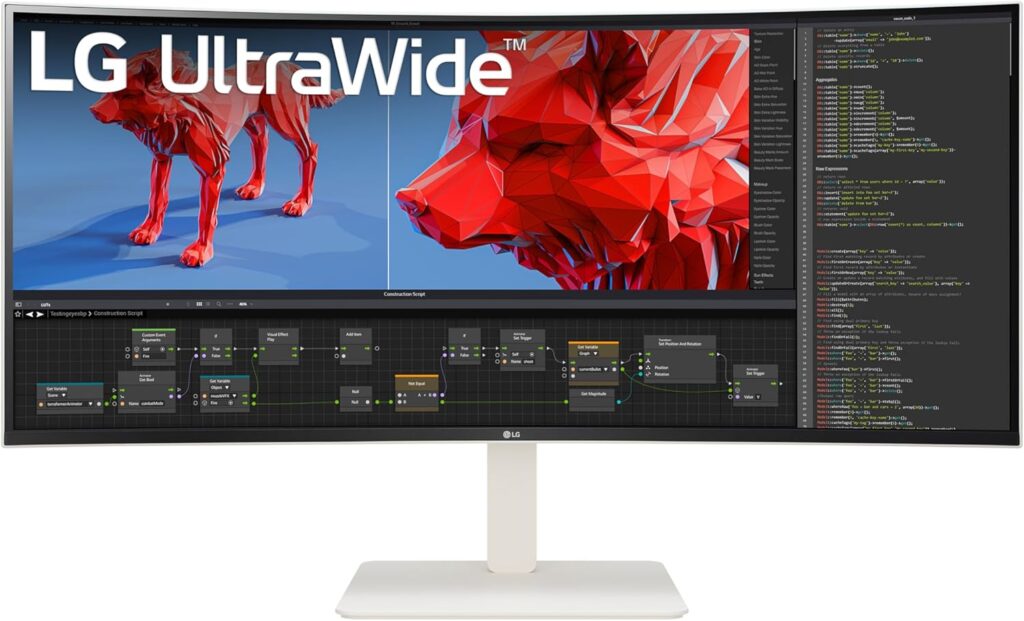
Key Specs:
- Screen Size: 38 inches
- Resolution: 3840 x 1600 (WQHD+)
- Panel Type: Nano IPS
- Refresh Rate: 144Hz
- Connectivity: HDMI 2.1, USB Type-C (90W PD), Ethernet, USB Hub
- Features: HDR10, NVIDIA G-SYNC Compatible, AMD FreeSync Premium Pro, Built-in KVM Switch
Overview: The LG 38WR85QC-W is a feature-rich ultrawide monitor designed for professionals. Its expansive 38-inch Nano IPS display delivers vibrant colors and sharp details. The monitor’s 144Hz refresh rate and adaptive sync technologies ensure smooth visuals, catering to both work and play. Notably, it includes a built-in KVM switch, allowing users to control multiple devices with a single keyboard and mouse setup.
✅ Why We Like It:
- Comprehensive Connectivity: The inclusion of USB-C with 90W power delivery, Ethernet, and multiple USB ports simplifies connectivity.
- Built-in KVM Switch: Enhances productivity by allowing seamless switching between devices.
- High Refresh Rate: The 144Hz refresh rate provides smooth motion, beneficial for video editing and gaming.
❌ Why We Don’t Like It:
- Price Point: As a premium monitor, it comes with a higher price tag, which may not fit all budgets.
- Size Considerations: The 38-inch size requires ample desk space and may be overwhelming for some users.
Dell U4025QW
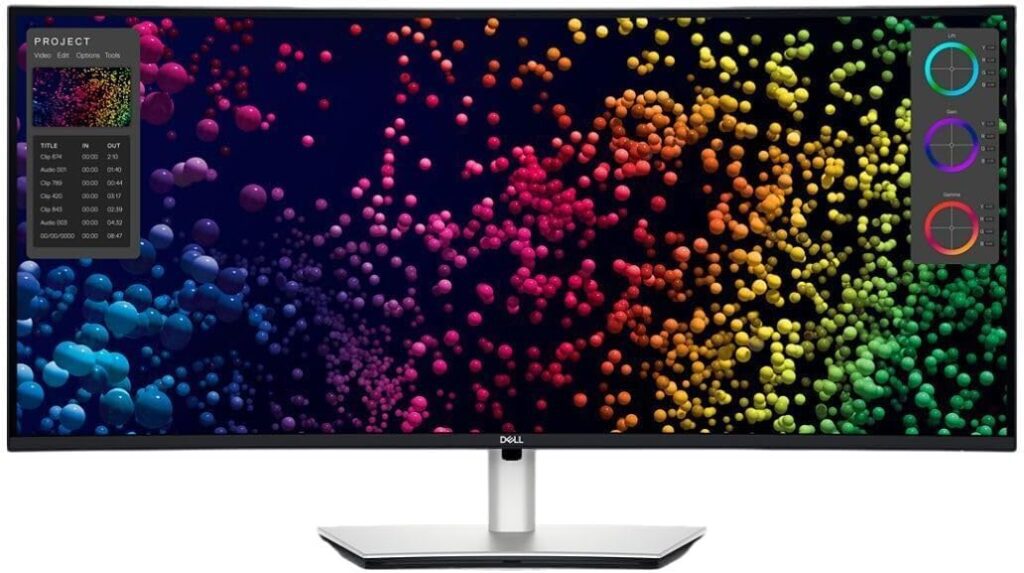
Key Specs:
- Screen Size: 40 inches
- Resolution: 5120 x 2160 (5K2K)
- Panel Type: IPS Black
- Refresh Rate: 120Hz
- Connectivity: Thunderbolt 4, HDMI 2.1, DisplayPort, USB Hub
- Features: HDR600, KVM Switch, Picture-by-Picture (PBP)
Overview: The Dell U4025QW is a 40-inch ultrawide monitor that boasts a 5K2K resolution, offering exceptional detail and clarity. Its IPS Black panel technology provides deeper blacks and enhanced contrast ratios. With a 120Hz refresh rate, it delivers smoother visuals, which is beneficial for both productivity and entertainment. The monitor’s extensive connectivity options, including Thunderbolt 4, make it versatile for various setups.
✅ Why We Like It:
- High Resolution: The 5K2K resolution offers sharp and detailed visuals, ideal for multitasking and content creation.
- Enhanced Contrast: IPS Black technology provides deeper blacks, improving overall image quality.
- Productivity Features: Features like the KVM switch and PBP mode enhance multitasking capabilities.
❌ Why We Don’t Like It:
- Limited Motion Handling: Despite the 120Hz refresh rate, motion handling may not be optimal for fast-paced gaming.RTINGS+2RTINGS+2Display Ninja+2
- Premium Pricing: The advanced features and high resolution come at a higher cost.
Best Ultrawide Monitors for Gaming
Quick Comparison
| Monitor | Screen Size | Resolution | Refresh Rate | Response Time | Curvature | Features | Buy Now |
|---|---|---|---|---|---|---|---|
| Samsung Odyssey G9 | 49 inches | 5120 x 1440 | 240Hz | 0.03ms (GtG) | 1000R | G-SYNC, FreeSync, HDR1000 | Check Price |
| MSI MPG 341CQPX | 34 inches | 3440 x 1440 | 240Hz | 0.03ms (GtG) | 1800R | FreeSync Premium Pro, HDR True Black 400 | Check Price |
| LG 45GR95QE-B UltraGear OLED | 45 inches | 3440 x 1440 | 240Hz | 0.03ms (GtG) | 800R | G-SYNC, FreeSync Premium, HDR400 | Check Price |
Samsung 49″ Odyssey G9 Curved Gaming Monitor
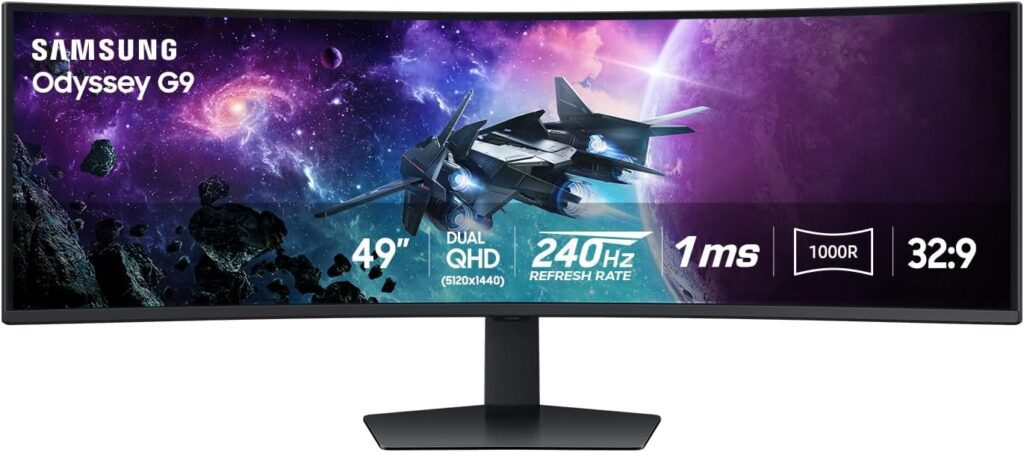
Key Specs:
- Screen Size: 49 inches
- Resolution: 5120 x 1440 (Dual QHD)
- Panel Type: QD-OLED
- Refresh Rate: Up to 240Hz
- Response Time: 0.03ms (GtG)
- Curvature: 1000R
- Connectivity: HDMI 2.1, DisplayPort 1.4, USB Hub
- Features: NVIDIA G-SYNC Compatible, AMD FreeSync Premium Pro, VESA DisplayHDR 1000
Overview: The Samsung Odyssey G9 is a flagship ultrawide gaming monitor that offers an immersive experience with its expansive 49-inch QD-OLED display and aggressive 1000R curvature. The Dual QHD resolution ensures sharp visuals, while the 240Hz refresh rate and 0.03ms response time provide smooth and responsive gameplay. Compatibility with both NVIDIA G-SYNC and AMD FreeSync Premium Pro ensures tear-free gaming sessions.
✅ Why We Like It:
- Immersive Experience: The 1000R curvature closely matches the human eye’s field of view, enhancing immersion.
- High Performance: The combination of a 240Hz refresh rate and ultra-fast response time caters to competitive gaming needs.
- Advanced Features: Support for HDR1000 delivers vibrant colors and deeper contrasts.
❌ Why We Don’t Like It:
- Desk Space: Its substantial size requires a large desk area.
- Price Point: Premium features come with a higher price tag.
MSI MPG 341CQPX QD-OLED

Key Specs:
- Screen Size: 34 inches
- Resolution: 3440 x 1440 (UWQHD)
- Panel Type: QD-OLED
- Refresh Rate: Up to 240Hz
- Response Time: 0.03ms (GtG)
- Curvature: 1800R
- Connectivity: HDMI 2.1, DisplayPort 1.4, USB-C
- Features: AMD FreeSync Premium Pro, VESA DisplayHDR True Black 400
Overview: The MSI MPG 341CQPX features a 34-inch QD-OLED panel that delivers vibrant colors and deep blacks. Its 1800R curvature offers a balanced immersive experience without being overly aggressive. With a 240Hz refresh rate and 0.03ms response time, it ensures fluid and responsive gameplay. The inclusion of AMD FreeSync Premium Pro and HDR support enhances visual quality.
✅ Why We Like It:
- Vivid Visuals: QD-OLED technology provides exceptional color accuracy and contrast.
- Smooth Gameplay: High refresh rate and low response time minimize motion blur and input lag.
- Adaptive Sync: FreeSync Premium Pro ensures a tear-free gaming experience.
❌ Why We Don’t Like It:
- Brightness Levels: Peak brightness may be lower compared to some competitors.
- Size Limitation: The 34-inch screen might feel limited for gamers seeking larger displays.
LG 45GR95QE-B 45″ UltraGear OLED
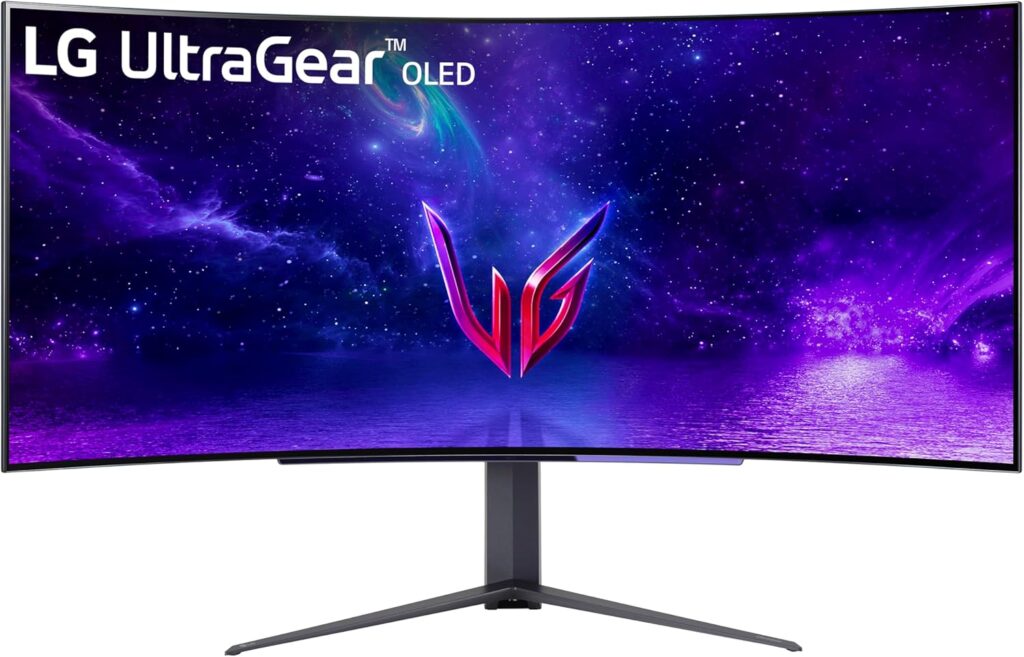
Key Specs:
- Screen Size: 45 inches
- Resolution: 3440 x 1440 (WQHD)
- Panel Type: OLED
- Refresh Rate: Up to 240Hz
- Response Time: 0.03ms (GtG)
- Curvature: 800R
- Connectivity: HDMI 2.1, DisplayPort 1.4, USB Hub
- Features: NVIDIA G-SYNC Compatible, AMD FreeSync Premium, VESA DisplayHDR 400
Overview: The LG 45GR95QE-B stands out with its 45-inch OLED display and pronounced 800R curvature, offering deep blacks and vibrant colors. The 240Hz refresh rate and near-instantaneous response time cater to fast-paced gaming. Compatibility with both G-SYNC and FreeSync ensures smooth visuals, and HDR support enhances the overall picture quality.
✅ Why We Like It:
- OLED Excellence: Delivers true blacks and high contrast ratios for immersive visuals.
- High Refresh Rate: Supports fast and fluid gameplay experiences.
- Wide Compatibility: Works seamlessly with both NVIDIA and AMD graphics cards.
❌ Why We Don’t Like It:
- Aggressive Curvature: The 800R curve may require an adjustment period for some users.
- Burn-In Risk: As with all OLEDs, there’s a potential for image retention over time.
Final Thoughts – Why Ultrawide is the Future
The best ultrawide monitors 2025 combine performance, immersion, and ergonomic advantages that make them a superior choice for both work and play. Whether you’re looking for the best 144Hz ultrawide monitor for gaming, a 4K ultrawide for content creation, or a USB-C ultrawide for your MacBook Pro, there’s a perfect option available.
Related Articles
📌 240Hz vs 144Hz Gaming Monitors: Should You Upgrade?
📌 Best Dual Monitor Setup for Productivity (2025 Picks You’ll Love!)
📌 How to Reduce Eye Strain with Monitor Settings: The Ultimate Guide (2025)!
📌 IPS vs. VA vs. TN vs. OLED vs. QLED: Which Monitor Panel is Best in 2025?
📌 Curved vs Flat Monitors: Pros, Cons & Best Picks (Ultimate Guide 2025)
Frequently Asked Questions (FAQ)
What does ultrawide mean?
An ultrawide monitor features a wider aspect ratio than standard displays, typically 21:9 or 32:9, providing more horizontal screen space. This design enhances multitasking, gaming, and immersive viewing experiences.
Is ultrawide 1440p or 4K?
Ultrawide monitors can support various resolutions, including 1440p and 4K. For instance, a common ultrawide resolution is 3440×1440 (UWQHD), offering a 21:9 aspect ratio. Some ultrawide monitors also feature 4K resolutions, such as 5120×2160, providing enhanced clarity and detail.
Is 3440 by 1440 21:9?
Yes, a resolution of 3440×1440 corresponds to a 21:9 aspect ratio, commonly found in ultrawide monitors. This aspect ratio offers a broader field of view compared to standard 16:9 monitors, enhancing both productivity and gaming experiences.
Is ultrawide more demanding?
Ultrawide monitors require more graphical processing power due to their increased pixel count, especially at higher resolutions like 3440×1440 or 5120×2160. This can impact performance in gaming and other graphics-intensive applications, necessitating a more powerful GPU.
What is the disadvantage of ultrawide monitors?
While ultrawide monitors offer enhanced immersion and productivity, they also have potential drawbacks:
Compatibility Issues: Some games and applications may not support ultrawide resolutions, leading to stretched or letterboxed visuals.
Increased Hardware Demands: Higher resolutions require more powerful hardware to maintain optimal performance.
Desk Space Requirements: The larger size of ultrawide monitors necessitates more desk space and may require ergonomic adjustments.
When considering the Best Ultrawide Monitors 2025, it’s essential to weigh these factors against your specific needs and setup.
